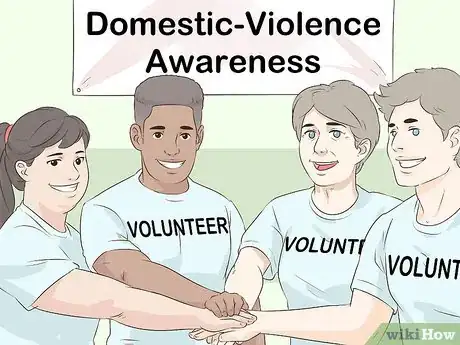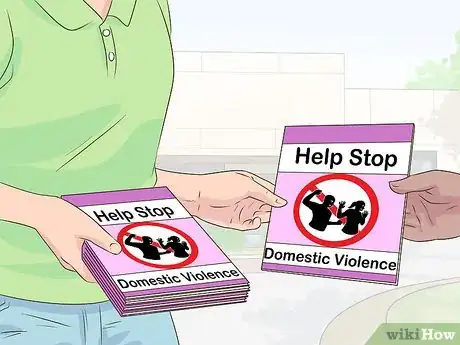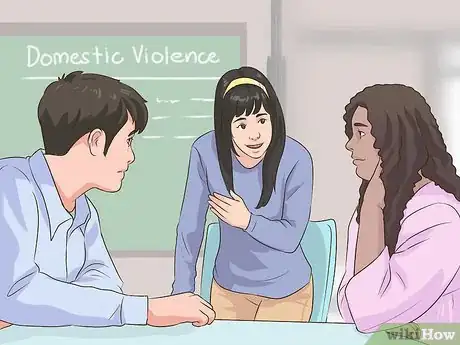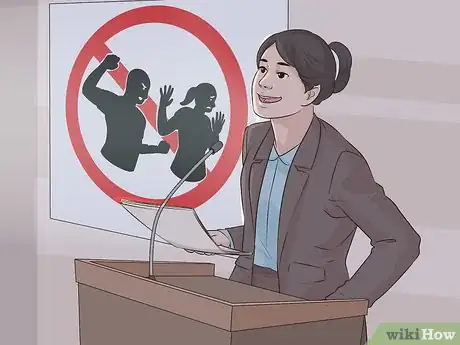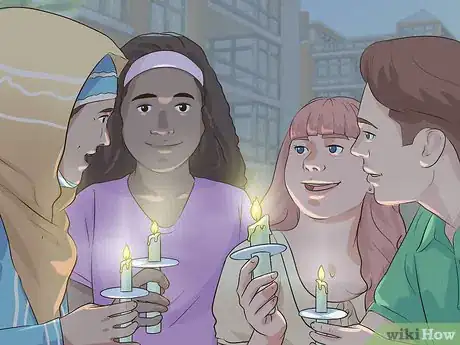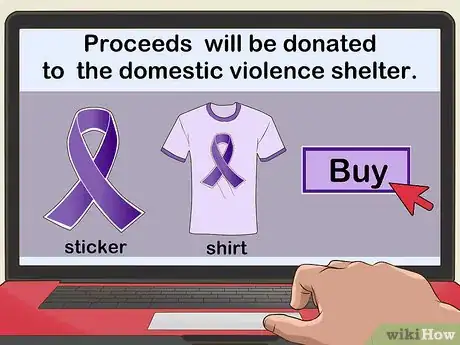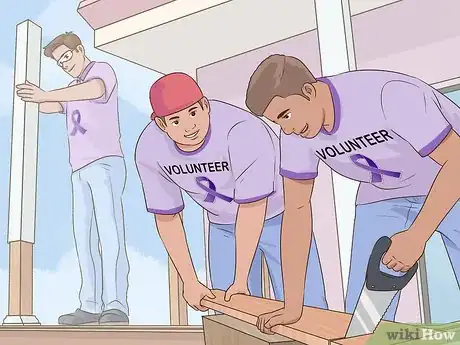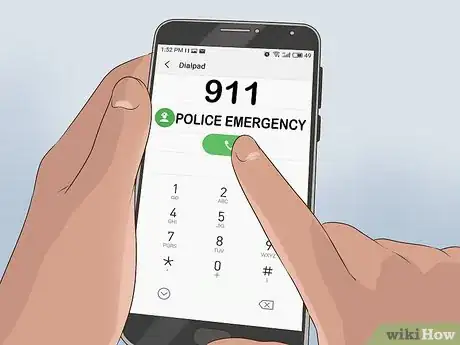This article was co-authored by Saul Jaeger, MS. Saul Jaeger is a Police Officer and Captain of the Mountain View, California Police Department (MVPD). Saul has over 17 years of experience as a patrol officer, field training officer, traffic officer, detective, hostage negotiator, and as the traffic unit’s sergeant and Public Information Officer for the MVPD. At the MVPD, in addition to commanding the Field Operations Division, Saul has also led the Communications Center (dispatch) and the Crisis Negotiation Team. He earned an MS in Emergency Services Management from the California State University, Long Beach in 2008 and a BS in Administration of Justice from the University of Phoenix in 2006. He also earned a Corporate Innovation LEAD Certificate from the Stanford University Graduate School of Business in 2018.
There are 16 references cited in this article, which can be found at the bottom of the page.
This article has been viewed 50,854 times.
Raising domestic violence awareness can help victims find professional counseling and prevent more people from getting hurt. Expressing how far this issue reaches may involve educating the community about different types of domestic violence, participating in organizations that campaign against domestic violence, and speaking out against acts of violence. Raising awareness is a team effort and one that will take time and energy. Even if it may seem tiring, remember that you are contributing to improving your community and helping others feel more comfortable with themselves and others!
Steps
Educating Yourself
-
1Study media focused around domestic violence survivors. Domestic violence survivors who have chosen to tell their stories can provide the best perspective about how domestic violence occurs. You can find material regarding these topics at the library, your local domestic violence shelter, and online.
- The National Resource Center on Domestic Violence acts as a comprehensive online resource for anyone who wants to educate themselves. Their website includes radio broadcasts, educational podcasts, and selected reading material.[1]
- As literature and awareness about domestic violence grows, abusers may shift how they present themselves to remain hidden. This makes it important to stay up-to-date on current podcasts, books, and articles, not just big cases in the past. [2]
-
2Attend events in your community. Attending events like talks, fundraisers, and community service days gives you the opportunity to connect with others who also want to raise awareness about domestic violence. You can also meet survivors and professionals who can offer advice on how to get involved.
- Your town’s city hall website should have an online calendar for local events available. If there is no website, the city hall often has a physical calendar posted up or within a brochure. You can also directly call them and inquire about local events.
- Nearby colleges frequently host events regarding social change. Much like for neighborhoods, you can find an event calendar on most college websites.
- Apps like Eventbrite, MeetUp, and Gravy can also help you find local gatherings that may not be considered large enough for a town hall posting.[3]
Advertisement -
3Stay open minded about what others have to say. Domestic violence can take on many forms. Even if someone’s specific case sounds unusual or strange, it is better to understand where they are coming from.[4]
Teaching the Community
-
1Distribute educational material and local resources. Light educational materials like brochures and pamphlets are an easy way to spread information about domestic violence within your community. You can gather brochures at most domestic violence shelters.
- The material should include statistics that outline how prevalent domestic violence is. While national statistics can be eye-opening, local numbers can have more of an impact as they show your neighbors how it affects them. Contact information about how to access hotlines, local domestic violence shelters, and where to volunteer should also be included to motivate action.
- If you don’t have shelters in your area, brochures and other material can be printed out online.[7]
- Ask local businesses and facilities about leaving some brochures in their community area. Many coffee shops, churches, and community centers will let you leave some behind if you ask.
-
2Participate and communicate in local talks and events. Your voice can be the most powerful tool against domestic violence. Research the works of past speakers and survivors, share their stories with your community, and encourage new ideas on how to prevent future acts of domestic violence.
- Outside of talks and events, you can share the stories of survivors through social media channels.
-
3Invite guest speakers to hold talks at schools and community centers. Guest speakers can provide valuable, researched insight into how and why domestic violence occurs. Much like with brochures, local domestic violence shelters often have a connection to at least one guest speaker you can meet and schedule an event with.
- Guest speakers can include survivors of domestic violence, professionals who work with survivors like a psychologist or lawyer, or those who research cases of domestic violence like a police officer or journalist.
- You can connect with a guest speaker using online channels like the National Speakers Association. Such sites allow you to search for speakers by topic, view their profile and past speeches, and request a scheduled date to speak. [8]
Speaking Out Against Domestic Violence
-
1Hold others around you accountable. If someone around you jokes about domestic violence or trivializes the topic, openly acknowledge it. Most people will not notice or ignore subtle hints that something may be wrong.
- Most people get defensive if you directly accuse them of saying something offensive. Instead, try a more diplomatic approach such as “What do you mean by that?” or “I know it’s not what you meant, but what you said made me uncomfortable.” Such language encourages an open dialogue.[9]
- Look out for bad faith tactics like pointing out the behavior of someone else (which is often irrelevant to the conversation), acting like they are just "playing around," or calling you too sensitive. Such actions are only meant to frustrate and exhaust you, and should be taken as a sign to disengage.[10]
-
2Recognize signals that someone you know may be an abuser. It can be difficult to think that someone you know or care about is an abuser, but ignoring signals is often how many abusers get away with their behavior. There are several signs that may point to abusive behavior:
- The person often conveys that they are jealous, and does not think the victim should be with other people unsupervised.
- The person gets mad often, and blames the victim if the anger leads to direct or indirect violence.
- The person is constantly policing what their partner wears, says, and buys.
-
3Host candlelight vigils in honor of domestic abuse victims. It can be hard to understand how far-reaching the effects of domestic violence can be. A candlelight vigil that displays how many people experience domestic violence may be difficult, but can be the wake-up call your community needs to take action.
- Candlelight vigils can trigger unpleasant memories for abuse survivors. Make sure you have a trained professional on site to help anyone who may experience symptoms of post-traumatic stress disorder or feels a sudden rush of panic.[11]
Supporting Victims of Domestic Violence
-
1Buy products from companies that send proceeds to domestic violence shelters. Products that have the purple ribbon on them are marked to speak out against domestic violence. Wear clothes with the purple ribbon on them, or buy a purple ribbon to decorate your car, home, or notebook as a message against domestic violence.[12]
- Be careful who you buy from. Some companies use the purple ribbon as nothing more than a marketing opportunity and send little - if any - funds to shelters.
-
2Raise money for local domestic violence support shelters. Starting a fundraiser or setting up a monthly donation through your bank account can help local shelters offer more professional help to victims of domestic violence. Many shelters have dedicated pages on their website detailing how you can donate money safely.
- Local businesses, churches, and schools can help contribute to fundraising efforts by asking customers for a donation, or submitting a portion of their proceeds to a shelter.
- Some fundraising ideas for domestic violence shelters can include bake sales, musical performances, and marathon pledges.
-
3Volunteer at your local domestic violence shelter. Call your local shelter and ask if you can volunteer at their location or any of their planned events. Most shelters are non-profit and can use any help that you can get. This also gives you an opportunity to gain some perspective from domestic violence victims.
- Volunteer work can range from setting up an event, counseling for victims, or working as a hotline operator. Ask what opportunities are available at your shelter.
-
4Listen to victims who disclose their experience of domestic violence to you. It is never easy to listen to someone’s experience about domestic abuse, but being the shoulder to cry on can offer much needed piece of mind for the victim. In these cases it is best to stay quiet, let the other person talk, and show that you care - even if you may not fully understand.
- Be mindful of what the person experiencing the abuse may want in this situation. You may be tempted to call the police right away, but this may not always be the best option.[13]
- Consult with the victim on a safety plan that they are comfortable with, and inform them of local shelters and other resources that can offer professional support. The victim may not want to seek help immediately, but that is their decision to make.
-
5Call the police if you absolutely feel the victim’s safety is at risk. If you believe the abuser’s actions are beginning to cross a threshold where a victim’s safety or life is at risk, you may have to make the decision of getting authorities involved.
- If a victim you know is avoiding social interaction more often, it may be because they are hiding bruises or other scars from violence. This may also be the case if you notice they are wearing more makeup than usual.[14]
- Keep a journal of all the times the victim or you have noted instances of domestic violence from the abuser. A comprehensive timeline will make a stronger case for the police.
- The victim may not want the police involved for several reasons such as immigration, healthcare, or billing. If this is the case, contact your local shelter for professional assistance.
Warnings
- Never confront the abuser. If you feel that the abuser must be stopped at once, contact local authorities.⧼thumbs_response⧽
References
- ↑ https://www.nrcdv.org/
- ↑ https://www.mayoclinic.org/healthy-lifestyle/adult-health/in-depth/domestic-violence/art-20048397
- ↑ https://www.hongkiat.com/blog/apps-events-activities-around-you/
- ↑ https://ww3.aauw.org/2016/03/30/fight-your-biases/
- ↑ http://www.aaets.org/article144.htm
- ↑ https://goodmenproject.com/featured-content/bnr-women-feel-unsafe-and-you-can-change-that/
- ↑ http://www.stopabuseforeveryone.org/finding-help/brochures.html
- ↑ https://www.nsaspeaker.org/find-speaker/
- ↑ https://hbr.org/2017/02/how-to-respond-to-an-offensive-comment-at-work
- ↑ https://lifehacker.com/when-to-stop-trying-to-win-an-argument-1797876592
- ↑ http://d3n8a8pro7vhmx.cloudfront.net/jubileeusa/legacy_url/1011/JubileeCandleLightVigil.pdf?1501806290
- ↑ https://www.domesticshelters.org/domestic-violence-articles-information/october-is-domestic-violence-awareness-month#.Wg3ghWhSxPY
- ↑ https://www.thehotline.org/resources/someone-i-know-is-being-abused-should-i-call-the-police/
- ↑ https://www.healthyplace.com/abuse/domestic-violence/signs-of-domestic-violence-domestic-abuse/
- ↑ https://www.psychologytoday.com/blog/when-your-adult-child-breaks-your-heart/201510/5-facts-everyone-must-know-about-domestic
- ↑ Saul Jaeger, MS. Police Captain, Mountain View Police Department. Expert Interview. 21 February 2020.

